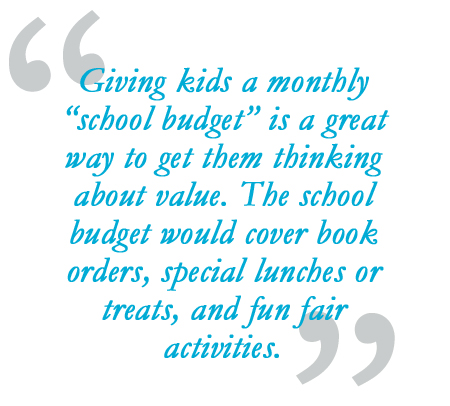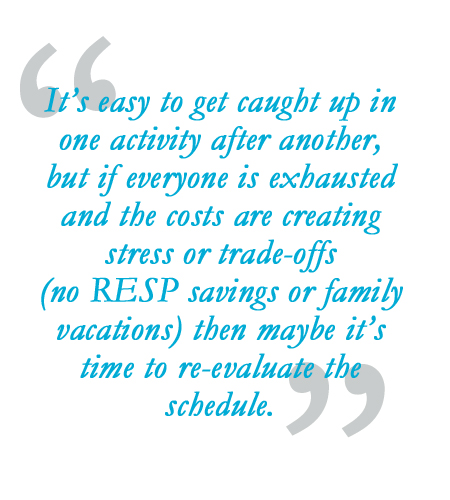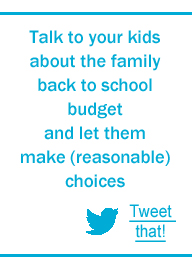By Karen Richardson, FPSC Level 1® and Christine White, P.Eng., FPSC Level 1®
The back to school cliché is that kids dread it and parents are gleefully counting the hours. But in reality, lots of kids are excited to go back to school (albeit an excitement that usually fades with the first homework assignment) and many parents dread September because it feels like open season on their bank accounts. Back to school spending seems to escalate every year, but it doesn’t have to be that way. You may not be able to keep your kids excited about school, but saving on back to school expenses is possible with some planning.
Back to school basics
Don’t start from scratch

A costly mistake many parents make is buying everything new. School ended roughly 8 weeks ago. It is entirely likely that much of what your children wore last spring still fits them. The same goes for school supplies; rulers, binders, folders, pencil cases, calculators, erasers, etc… are often in fine shape for the new school year. Before you head to the mall make an inventory of what you already have.
Kids don’t need everything on the first day
Even if your stock taking reveals that the kids will need several new items to get through the year, they won’t likely need winter boots in the first several weeks. Keep purchases to the essentials by building on what they have and then start watching for sales. The holidays are just around the corner and adding to the kids’ wardrobe through birthday and Christmas gifts is also a great idea.
Get the kids involved
Some kids love new running shoes; other kids are into trendy binders and pencil cases. Talk to your kids about how much money is in the back to school budget and let them make (reasonable) choices. Maybe using last year’s backpack is worth it if it means they can have those jeans they really love.
It may be too late for this year, but planning ahead is important. As a parent you’ll be facing these same expenses for at least 15 years. Putting money in a back to school account every payday, for six months to a year in advance, will significantly lower your financial stress in the fall. With money put aside, and no need to pull out your credit card for every purchase, you’re more likely to stick to your budget.
Ongoing school costs
Just when you think you have it all handled and everyone is back into their daily routine, the notices start appearing in the backpacks: school fundraisers, charity events, order forms for pizza day, field trip permission forms (check due by Friday please). You’re really pleased that your kids have shown an interest in books, but the book order forms arrive faster than they can read. And don’t forget to buy the supplies for a medieval castle diorama, it’s due on Monday. It just doesn’t stop.
Create some structure
These extra expenses may pop-up suddenly, but if this isn’t your first year with a child in school you are probably more overwhelmed than surprised. The key, as always, is the planning. Have a monthly amount budgeted to cover the fundraisers and field trips and project supplies. Put that money aside each month even if there hasn’t been a request; you  know it’s coming, and several usually pop up at once, especially around Christmas when you are already spending more than usual. This may not lower the amount you have to spend, but it does allow you to be in charge of your cash flow.
know it’s coming, and several usually pop up at once, especially around Christmas when you are already spending more than usual. This may not lower the amount you have to spend, but it does allow you to be in charge of your cash flow.
Teach the kids to make choices
Not everything we are asked to pay for is a school necessity. Yes, we want our kids to have a great school experience, but it’s never too early to start teaching money skills. Giving them a monthly “school budget” is a great way to get them thinking about value. The school budget would cover book orders, special lunches or treats, fun fair activities etc. The kids, with your help if they are young, can decide if they want to spend their money on several books, or if they would prefer to save some for a hamburger lunch one Friday. It’s amazing what isn’t a “must have” for kids when they are empowered to make their own choices.
Extra-curricular activities
Not many would argue the importance of having kids involved in sports and/or the arts; the benefits to building character, self-esteem, physical and mental health are undeniable. But if you are looking for ways to save money on a tight budget, the cost of children’s activities and lessons presents a real challenge, especially since the fitness and arts tax credits, worth up to $150 and $75 respectively for those who claim them, will be cut in half for 2016 and eliminated for 2017.
Take a look at the big picture and plan ahead
In the words of the Boy Scouts and Girls Guides: Be Prepared. Write down all the activities and summer camps your kids are involved with over the course of a year. You can download and use this excel worksheet to get you started. Warning: the total is going to shock you, most parents underestimate what they spend on extra-curricular activities. But  if you divide this total by 12 and put money away monthly in a separate savings account, (an automatic transfer is a good idea) you will find that the stress around kids’ activities will decrease significantly.
if you divide this total by 12 and put money away monthly in a separate savings account, (an automatic transfer is a good idea) you will find that the stress around kids’ activities will decrease significantly.
Ask about alternative payment plans
The big organized sports often require full payment up front, but lots of other classes and smaller organizations offer monthly payment plans. It never hurts to ask. Payment plans can be a big help for your budgeting.
Take a fresh look at what your kids are involved in
It’s easy to get caught up in one activity after another, but if everyone is exhausted and the costs are creating stress or trade-offs (no RESP savings or family vacations) then maybe it’s time to re-evaluate the schedule. Maybe house league hockey makes more sense for the family than the extra costs and time associated with a rep team. The same goes for any sport or activity that offers a competitive option. Is your child shooting for a career or scholarship? If so, then the extra costs and time may be justified, but if it’s just because it’s more fun or their friends do it, then perhaps some hard decisions need to be made.
It’s a good idea to have a family discussion especially if you have more than one child, about the family’s time and financial capacity for activities as a whole. Instead of everyone running to different activities every night of the week, you may find everyone is happier with a little more home time.
Saving on back to school expenses will always be a challenge because we all want to provide the best we can for our children, but if we keep a few points in mind, we have a shot at an A+ back to school report card. In summary, here are three ways to save money and improve your cash flow as kids head back to school:
- Inventory what you already have: Don’t just assume you need a whole new wardrobe or brand new supplies.
- Plan ahead: Estimate what you’ll need for clothes, supplies and activities annually and start a monthly savings plan.
- Get the kids involved: Many people wish they were taught financial skills growing-up. Now’s your chance to do that for your kids! They need to learn and understand that every expense is part of a bigger financial picture.
If you would like to develop a spending and savings plan based on your family’s needs, contact a Money Coach today!

